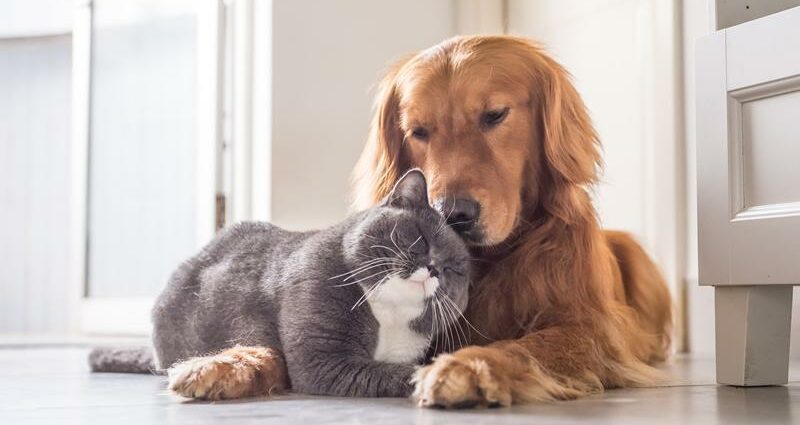Contents
Cat and dog at home: what to do for a good cohabitation?
Tradition has it that cats and dogs are natural enemies, unable to cohabit peacefully. However, many images and videos published online disprove this belief by representing touching moments of bond between felines and canines. This proves that living together, within the same household, is possible. Here are some tips to facilitate cohabitation.
During their development, puppies and kittens gradually become familiar with their environment. There is a sensitive period during which young people are particularly plastic, that is to say they are able to adapt to very diverse living conditions. Thus, before 14 weeks in dogs and 10 weeks in cats, babies should be introduced to other animals, of the same or different species, to prevent socialization disorders in adulthood.
When adopting your puppy or kitten, it will be at least 8 weeks old (minimum legal age). It is therefore preferable that this socialization work has been started before the arrival in your home, by the breeder.
Second step: choose a suitable animal
Whether you want to adopt a young animal or an adult, it is essential to learn about its character and its former living conditions.
Indeed, if the animal has never been in contact with an individual of the other species before, and in particular not during the period of socialization of the young, it is likely that the encounter will generate stress and ‘anxiety. The reaction of each animal (flight, aggression, ability to get used to it) will depend on its character and is often unpredictable. It is therefore more prudent to adopt a cat or a dog that has already cohabited peacefully with an animal of the other species.
The choice of the dog’s breed
Some breeds are also reluctant to cohabitate, especially among dogs. Hunting dogs, in particular, were selected on their instinct to hunt smaller mammals. They therefore very often consider cats as prey and it can be extremely complicated, if not impossible, to calm the relationship between the two animals if this is the case. Other breeds, such as sheepdogs such as Border Collies, sometimes tend to treat cats like cattle. Without showing aggression, he can therefore adopt an insistent behavior causing stress for the household cat.
Third step: adapt the living spaces
Dogs and cats occupy space in completely different ways. The dogs stay on the ground and generally respect the spaces that their master grants them. Cats, on the contrary, occupy three-dimensional space. Most of them appreciate having platforms available for jumping and sleeping at heights. This difference is very useful for arranging the fireplace in the most calming way possible. By taking care to provide spaces for everyone, this leaves the opportunity for each animal to isolate itself and thus live serenely within the home. Thus, providing the cat with hiding places and platforms (cat trees, shelves, etc.) allows him to keep the dog at a distance when he wishes. It is also possible to place their bowls at a height, to prevent them from being disturbed during their meals. The litter should also be placed in the shelter of the dog, in a quiet place. In the event of tension, it is also best not to leave the two animals alone in the same room, for example at night.
Promising adjuvant therapies
If, despite all these measures, the cohabitation between your dog and your cat remains difficult, there are other remedies to calm the relations within the household. Indeed, certain non-medicinal products can be administered to calm animals in a natural way. This is particularly the case with certain food supplements, phytotherapy products or pheromone diffusers. A recent study shows an improvement in dog-cat relationships in homes using dog pheromone diffusers and cat diffusers (increase in positive behaviors, decrease in negative behaviors and increase in a relaxation score). The effect noted was rapid (observed within a week) and lasting, over 6 weeks of administration.
In conclusion, it should be remembered that a peaceful cohabitation between dogs and cats is possible but difficult to predict. In order to optimize the chances, it is recommended to adopt animals that are properly socialized during their development and to avoid individuals who are naturally not very tolerant of animals of the other species. The layout of the home is also essential to create a reassuring environment for everyone.
Finally, adjuvant therapies with promising results are available to help calm animal relationships. However, it is important to keep in mind that some individuals will naturally be reluctant to live with a dog or a cat.
Proximity between household animals cannot be forced and it is essential to watch for signs of discomfort in each person to try to remedy it. Indeed, tensions are not always expressed by aggression but sometimes also by behavior of avoidance, prostration, etc. In the event of proven cohabitation difficulties, the best option to hope to improve relations is to work with a behavioral veterinarian.










